Mi Corazon es en Peru.
 In 1998 I made the first of several trips to the South American country of Peru. This first jaunt was a revelation and Peru has become perhaps my favorite foreign destination. That initial trip was made possible through the philanthropy of a Lilly Endowment Teacher Creativity Fellowship. These competitive fellowships offer Indiana teachers support for life-long learning . . . by enabling them to pursue dreams and passions, explore new areas of interest, expand existing talents, and develop new ones. How accurate their description and what excitement word of receiving a Fellowship created in our house! Anne and daughter Michelle surprised me with a tray holding the just arrived letter of selection emblazoned with the Lilly Endowment letterhead. Accompanying the announcement of my good fortune was a bottle of pinot grigio and three glasses. The celebration was on!
In 1998 I made the first of several trips to the South American country of Peru. This first jaunt was a revelation and Peru has become perhaps my favorite foreign destination. That initial trip was made possible through the philanthropy of a Lilly Endowment Teacher Creativity Fellowship. These competitive fellowships offer Indiana teachers support for life-long learning . . . by enabling them to pursue dreams and passions, explore new areas of interest, expand existing talents, and develop new ones. How accurate their description and what excitement word of receiving a Fellowship created in our house! Anne and daughter Michelle surprised me with a tray holding the just arrived letter of selection emblazoned with the Lilly Endowment letterhead. Accompanying the announcement of my good fortune was a bottle of pinot grigio and three glasses. The celebration was on!
Peru is a country of countless vistas. For many the Andes, Machu Picchu, and the cultural descendants of the Incas provide the allure. Exotic sounding destinations such as Cusco, Ollantaytambo, and Urubamba provide the Siren call which lures such folks to Peru. For me, the magnet-like pull originated from a different direction. To the east was the wonder that had tugged at my mind for years. As metal is drawn to lodestone, so were my imaginings drawn to the vast Peruvian Amazon. It was Iquitos and the great beyond which had long beckoned me, and now my dream was to be fulfilled. I was really going to experience the tropical rainforest of the Amazon Basin firsthand.
As a professional biologist how could I not be enraptured by the dream of seeing Amazonian Peru? The biodiversity harbored in this country is simply incredible. Compare these species counts from Peru with the comparable numbers (in parentheses) from my native Indiana. There are 40 000 (2000) species of plants, 1800 (260) species of birds, 500 (59) kinds of mammals, and nearly 800 (114) types of reptiles and amphibians. A single square mile of Peruvian rainforest may hold thousands of insect species. The Amazon River itself is home to some two thousand sorts of fishes as well as dolphins, a manatee, and several species of stingrays. A note on the term biodiversity; colloquially it simply means lots of different kinds of living things. Biologically speaking it implies more. When I use the term biodiversity, I also intend for it to encompass the interrelationships the organisms within a given area have with each other and their environment. As I prepared to leave Iquitos for the wilds of the Loreto Region, my pulse quickened with the thought of seeing and understanding some of the multitudinous ecological interrelations I might find lying ahead. I craved these often elusive yet exquisite gifts from the universe.
I left Indianapolis on the 4th of July after sharing a tearful goodbye with Anne. At that time, we had been married for over 30 years and this occasion was to be our first separation lasting more than a couple of days. Two weeks in Peru seemed like a terribly long time. A change of flights in Miami found me on an Aeroperu 757 bound for Iquitos. The angst of separation began to ease and was gradually replaced by an excited anticipation of the impending adventure.
Nowadays, it never ceases to amaze me how rapidly one can be conveyed to a far region of the earth. Spanish galleons once plied the seas over which I flew. Their journey between North and South America required weeks to complete. That day at 10:00AM I was in Indiana. At 9:30PM I stood in the airport in Iquitos, Peru. It has undeniably become a small world in which we live.
My arrival in Iquitos has entrenched itself in my memory. It is a lovely image which I enjoy downloading now and then from my cerebral memory bank. Like a favorite old Hollywood film, I can close my eyes and replay the scene that unfolded from my window as we began our descent. Night had fallen and, as the airplane banked into a descending turn to the southeast, a vast inky blackness was revealed to my view. Some fifteen thousand square miles of pitch-black obscurity lie below me – the rainforest of northeastern Peru. On the far distant horizon a tropical thunderstorm raged. Periodic fingers of lightning leaped through the air like bursts from some gigantic Tesla coil. Illuminated from within were great towers of cumulonimbus clouds. From these fell a deluge of rain, the vital essence of the wondrous ecosystem passing beneath our wings. The immense shadow that was the forest was pierced by one tiny cluster of lights. Like a miniscule island in the vast enormity of the ocean, the city of Iquitos twinkled in the profound darkness.
Iquitos lies on the Itaya River at its junction with the Amazon River. Over 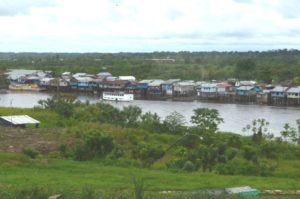 two thousand miles must be navigated downstream to reach the river’s mouth in Brazil. No roads arrive in Iquitos from the far away capital of Lima. No by-ways link Iquitos to the urban areas of next door neighbors Ecuador, Colombia, and Brazil. If one wants to venture here, one flies or voyages upon the Amazon. It is indeed an islet in a tropical rainforest sea.
two thousand miles must be navigated downstream to reach the river’s mouth in Brazil. No roads arrive in Iquitos from the far away capital of Lima. No by-ways link Iquitos to the urban areas of next door neighbors Ecuador, Colombia, and Brazil. If one wants to venture here, one flies or voyages upon the Amazon. It is indeed an islet in a tropical rainforest sea.
As I stood waiting for my luggage in the terminal of the Col. Francisco 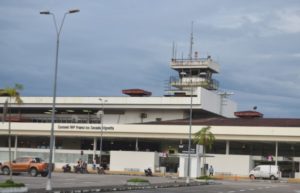 Vignetta International Airport, I took note of a familiar reminder that I was in the tropics. My glasses had lightly fogged and trickles of perspiration began to make leisurely meanders down my sides, wetting my shirt in the process. Having lived in tropical Southeast Asia for three years, the sensation wasn’t new to me. However, a few years in temperate Indiana had allowed me to forget just how incredibly humid the tropics can be. In fact regions which harbor tropical rainforest share several climatic characteristics, high humidity being just one of these. The average RH for the Iquitos area is in the low 80’s. Think of the hottest, most humid summer day that you can recall here in the Midwest and you have some idea of the feel, be it January or June, of the lowland tropics.
Vignetta International Airport, I took note of a familiar reminder that I was in the tropics. My glasses had lightly fogged and trickles of perspiration began to make leisurely meanders down my sides, wetting my shirt in the process. Having lived in tropical Southeast Asia for three years, the sensation wasn’t new to me. However, a few years in temperate Indiana had allowed me to forget just how incredibly humid the tropics can be. In fact regions which harbor tropical rainforest share several climatic characteristics, high humidity being just one of these. The average RH for the Iquitos area is in the low 80’s. Think of the hottest, most humid summer day that you can recall here in the Midwest and you have some idea of the feel, be it January or June, of the lowland tropics.
Length of day is remarkably constant as well. January finds the inhabitants of Iquitos enjoying a little over twelve hours of sunlight. In June, it is daylight for just under twelve hours. By comparison, in the Hoosier state the length of day varies from nearly fifteen hours in June to a bit less than nine and a half hours in December. Of course tropical temperatures, particularly at low elevations near the equator, are extraordinarily uniform  as well. The average high throughout the year in Iquitos is around 870F with nighttime temperatures running around 720F. (climatogram courtesy of Climate-Data.org) Here in the Midwestern U.S., differences between highs and lows throughout the year vary by a good 600F. In fact, here in Indiana a fast moving cold front, sweeping down from the Arctic, can drop the temperature that much in a matter of hours. And, of course, there is lots of rain. Iquitos receives a bit over one-hundred and ten inches per year compared with about forty inches here in Indiana.
as well. The average high throughout the year in Iquitos is around 870F with nighttime temperatures running around 720F. (climatogram courtesy of Climate-Data.org) Here in the Midwestern U.S., differences between highs and lows throughout the year vary by a good 600F. In fact, here in Indiana a fast moving cold front, sweeping down from the Arctic, can drop the temperature that much in a matter of hours. And, of course, there is lots of rain. Iquitos receives a bit over one-hundred and ten inches per year compared with about forty inches here in Indiana.
From a biological perspective such a uniform climate, with high amounts of solar energy and lots of water, results in tremendous plant productivity. There are no “time-outs” for a period of winter dormancy. Photosynthesis and biosynthesis are daily jobs in the tropics. With so much plant throughput, as well as diversity, it stands to reason that the biomass of animal life in the tropics is also quite high. However, there is an interesting difference between the biodiversity of the tropical rainforest and the temperature deciduous forest of my Indiana home.
A walk in a woodland near my homestead might reveal a forest heavily comprised of two or three kinds of oaks, sugar maple, shagbark hickory, and understory trees such as dogwood and redbud. Similarly there might be many individuals of a few representative animal groups such as woodpeckers, rodents, and carnivores. By comparison, in the tropical rain forest, there are many species but fewer individuals of each species in a given area. For example, Indiana has 110 species of trees. During a study in Peru, tropical biologist Dr. Alwyn Gentry (tragically lost in a 1993 airplane crash along with renowned Neotropical bird expert Ted Parker) found 300 tree species in a plot of forest a single hectare (2.5 acres) in size. In comparing animal diversity, we see similar trends. For example, there are 12 kinds of bats in Indiana while Peru is home to 180 species of chiropterans.
The planet’s undisputable super-river is the Amazon.
David Attenborough (Planet Earth: Freshwater)
The Amazon is the world’s largest river by volume. The output of water at its mouth is sufficient to fill the Superdome in New Orleans in less than twenty seconds. My first sight of this prodigious body of water did not disappoint. Leaving the Explorama Lodges’ Iquitos boat dock, I was soon gawking at a river still in excess of a mile wide even though I floated nearly 2300 miles from its mouth. Its depth is such that ocean-going ships can ascend the river to Iquitos. Even now two small, disheveled, and apparently well-traveled old freighters stood at anchor just offshore. My guide Pablo and I were aboard one of Explorama’s inboard-powered passenger boats (called a rapido) and off we roared toward the lodge some fifty miles downstream. To be out on the water and rapidly motoring downstream was refreshing and exhilarating. The cooling breeze generated by the boat’s motion quickly liberated me from the stifling humidity. I was able to contemplate and appreciate my first voyage upon the waters of this storied river.
The docks, warehouses, and dwellings of Iquitos began to dwindle away as we moved downstream. Plying the water with us were a variety of craft, exotic to my eyes, but common upon the Amazon. Three women, with a 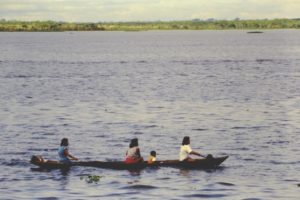 child and a sleeping infant, paddled their way upstream in a dugout canoe bound for the city and its storehouse of goods and urban marvels. Hugging the shoreline was another dugout; this one occupied by two children who couldn’t have been more than ten years old. They quietly fished for their family’s dinner as we sped onward. An open skiff, known locally as a pequi-pequi , motored by a fisherman at the helm. The boat’s small four-stroke engine sang with the “peck-peck-peck” sound which gave the craft its indigenous name. Farther downstream another, larger boat came chugging into view making way for Iquitos. This was a craft known as a colectivo. Colectivos are the water-taxis of a region with no roads.
child and a sleeping infant, paddled their way upstream in a dugout canoe bound for the city and its storehouse of goods and urban marvels. Hugging the shoreline was another dugout; this one occupied by two children who couldn’t have been more than ten years old. They quietly fished for their family’s dinner as we sped onward. An open skiff, known locally as a pequi-pequi , motored by a fisherman at the helm. The boat’s small four-stroke engine sang with the “peck-peck-peck” sound which gave the craft its indigenous name. Farther downstream another, larger boat came chugging into view making way for Iquitos. This was a craft known as a colectivo. Colectivos are the water-taxis of a region with no roads. 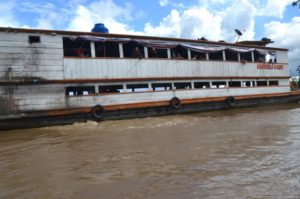 Frequently comprised of two or three decks, these boats are large by local river standards often measuring forty feet or more in length. The vessel was crowded with passengers. Some lounged, chatting in small groups. Others lazed in hammocks strung about in random exploitation of available spaces. Accompanying the human passengers was a menagerie of chickens, a couple of pigs, and what appeared to be a young Brahman steer. Pablo informed me that each of these critters, like the passengers, endured a fare equivalent to their perceived value.
Frequently comprised of two or three decks, these boats are large by local river standards often measuring forty feet or more in length. The vessel was crowded with passengers. Some lounged, chatting in small groups. Others lazed in hammocks strung about in random exploitation of available spaces. Accompanying the human passengers was a menagerie of chickens, a couple of pigs, and what appeared to be a young Brahman steer. Pablo informed me that each of these critters, like the passengers, endured a fare equivalent to their perceived value.
The sights, sounds, and ambiance of the river were so totally new and unfamiliar that I was seized by the sensation of being suddenly transported to a bizarre, new planet. I perceived a strangeness of circumstance, a sense of dissimilarity, the sensation of being markedly outside my comfort zone. I believe such perceptions are the essence of adventure travel. Such impressions constitute the compelling force that requires those of us with wanderlust to be constantly packing our bags. And so, onward I sped toward Explorama Lodge and my first night in the Neotropical rainforest.
Episode 2 will be coming soon and describes more of my observations and experiences in the Peruvian Amazon.
- Down the Amazon: Episode 1- Getting There
Mi Corazon es en Peru.
In 1998 I made the first of several trips to the South American country of Peru. This first jaunt was a revelation and Peru has become perhaps my favorite foreign destination. That initial trip was made possible through the philanthropy of a Lilly Endowment Teacher Creativity Fellowship. These competitive fellowships offer Indiana teachers support for life-long learning . . . by enabling them to pursue dreams and passions, explore new areas of interest, expand existing talents, and develop new ones. How accurate their description and what excitement word of receiving a Fellowship created in our house! Anne and daughter Michelle surprised me with a tray holding the just arrived letter of selection emblazoned with the Lilly Endowment letterhead. Accompanying the announcement of my good fortune was a bottle of pinot grigio and three glasses. The celebration was on!
Peru is a country of countless vistas. For many the Andes, Machu Picchu, and the cultural descendants of the Incas provide the allure. Exotic sounding destinations such as Cusco, Ollantaytambo, and Urubamba provide the Siren call which lures such folks to Peru. For me, the magnet-like pull originated from a different direction. To the east was the wonder that had tugged at my mind for years. As metal is drawn to lodestone, so were my imaginings drawn to the vast Peruvian Amazon. It was Iquitos and the great beyond which had long beckoned me, and now my dream was to be fulfilled. I was really going to experience the tropical rainforest of the Amazon Basin firsthand.
As a professional biologist how could I not be enraptured by the dream of seeing Amazonian Peru? The biodiversity harbored in this country is simply incredible. Compare these species counts from Peru with the comparable numbers (in parentheses) from my native Indiana. There are 40 000 (2000) species of plants, 1800 (260) species of birds, 500 (59) kinds of mammals, and nearly 800 (114) types of reptiles and amphibians. A single square mile of Peruvian rainforest may hold thousands of insect species. The Amazon River itself is home to some two thousand sorts of fishes as well as dolphins, a manatee, and several species of stingrays. A note on the term biodiversity; colloquially it simply means lots of different kinds of living things. Biologically speaking it implies more. When I use the term biodiversity, I also intend for it to encompass the interrelationships the organisms within a given area have with each other and their environment. As I prepared to leave Iquitos for the wilds of the Loreto Region, my pulse quickened with the thought of seeing and understanding some of the multitudinous ecological interrelations I might find lying ahead. I craved these often elusive yet exquisite gifts from the universe.
I left Indianapolis on the 4th of July after sharing a tearful goodbye with Anne. At that time, we had been married for over 30 years and this occasion was to be our first separation lasting more than a couple of days. Two weeks in Peru seemed like a terribly long time. A change of flights in Miami found me on an Aeroperu 757 bound for Iquitos. The angst of separation began to ease and was gradually replaced by an excited anticipation of the impending adventure.
Nowadays, it never ceases to amaze me how rapidly one can be conveyed to a far region of the earth. Spanish galleons once plied the seas over which I flew. Their journey between North and South America required weeks to complete. That day at 10:00AM I was in Indiana. At 9:30PM I stood in the airport in Iquitos, Peru. It has undeniably become a small world in which we live.
My arrival in Iquitos has entrenched itself in my memory. It is a lovely image which I enjoy downloading now and then from my cerebral memory bank. Like a favorite old Hollywood film, I can close my eyes and replay the scene that unfolded from my window as we began our descent. Night had fallen and, as the airplane banked into a descending turn to the southeast, a vast inky blackness was revealed to my view. Some fifteen thousand square miles of pitch-black obscurity lie below me – the rainforest of northeastern Peru. On the far distant horizon a tropical thunderstorm raged. Periodic fingers of lightning leaped through the air like bursts from some gigantic Tesla coil. Illuminated from within were great towers of cumulonimbus clouds. From these fell a deluge of rain, the vital essence of the wondrous ecosystem passing beneath our wings. The immense shadow that was the forest was pierced by one tiny cluster of lights. Like a miniscule island in the vast enormity of the ocean, the city of Iquitos twinkled in the profound darkness.
Iquitos lies on the Itaya River at its junction with the Amazon River. Over two thousand miles must be navigated downstream to reach the river’s mouth in Brazil. No roads arrive in Iquitos from the far away capital of Lima. No by-ways link Iquitos to the urban areas of next door neighbors Ecuador, Colombia, and Brazil. If one wants to venture here, one flies or voyages upon the Amazon. It is indeed an islet in a tropical rainforest sea.
As I stood waiting for my luggage in the terminal of the Col. Francisco Vignetta International Airport, I took note of a familiar reminder that I was in the tropics. My glasses had lightly fogged and trickles of perspiration began to make leisurely meanders down my sides, wetting my shirt in the process. Having lived in tropical Southeast Asia for three years, the sensation wasn’t new to me. However, a few years in temperate Indiana had allowed me to forget just how incredibly humid the tropics can be. In fact regions which harbor tropical rainforest share several climatic characteristics, high humidity being just one of these. The average RH for the Iquitos area is in the low 80’s. Think of the hottest, most humid summer day that you can recall here in the Midwest and you have some idea of the feel, be it January or June, of the lowland tropics.
Length of day is remarkably constant as well. January finds the inhabitants of Iquitos enjoying a little over twelve hours of sunlight. In June, it is daylight for just under twelve hours. By comparison, in the Hoosier state the length of day varies from nearly fifteen hours in June to a bit less than nine and a half hours in December. Of course tropical temperatures, particularly at low elevations near the equator, are extraordinarily uniform as well. The average high throughout the year in Iquitos is around 870F with nighttime temperatures running around 720F. (climatogram courtesy of Climate-Data.org) Here in the Midwestern U.S., differences between highs and lows throughout the year vary by a good 600F. In fact, here in Indiana a fast moving cold front, sweeping down from the Arctic, can drop the temperature that much in a matter of hours. And, of course, there is lots of rain. Iquitos receives a bit over one-hundred and ten inches per year compared with about forty inches here in Indiana.
From a biological perspective such a uniform climate, with high amounts of solar energy and lots of water, results in tremendous plant productivity. There are no “time-outs” for a period of winter dormancy. Photosynthesis and biosynthesis are daily jobs in the tropics. With so much plant throughput, as well as diversity, it stands to reason that the biomass of animal life in the tropics is also quite high. However, there is an interesting difference between the biodiversity of the tropical rainforest and the temperature deciduous forest of my Indiana home.
A walk in a woodland near my homestead might reveal a forest heavily comprised of two or three kinds of oaks, sugar maple, shagbark hickory, and understory trees such as dogwood and redbud. Similarly there might be many individuals of a few representative animal groups such as woodpeckers, rodents, and carnivores. By comparison, in the tropical rain forest, there are many species but fewer individuals of each species in a given area. For example, Indiana has 110 species of trees. During a study in Peru, tropical biologist Dr. Alwyn Gentry (tragically lost in a 1993 airplane crash along with renowned Neotropical bird expert Ted Parker) found 300 tree species in a plot of forest a single hectare (2.5 acres) in size. In comparing animal diversity, we see similar trends. For example, there are 12 kinds of bats in Indiana while Peru is home to 180 species of chiropterans.
The planet’s undisputable super-river is the Amazon.
David Attenborough (Planet Earth: Freshwater)
The Amazon is the world’s largest river by volume. The output of water at its mouth is sufficient to fill the Superdome in New Orleans in less than twenty seconds. My first sight of this prodigious body of water did not disappoint. Leaving the Explorama Lodges’ Iquitos boat dock, I was soon gawking at a river still in excess of a mile wide even though I floated nearly 2300 miles from its mouth. Its depth is such that ocean-going ships can ascend the river to Iquitos. Even now two small, disheveled, and apparently well-traveled old freighters stood at anchor just offshore. My guide Pablo and I were aboard one of Explorama’s inboard-powered passenger boats (called a rapido) and off we roared toward the lodge some fifty miles downstream. To be out on the water and rapidly motoring downstream was refreshing and exhilarating. The cooling breeze generated by the boat’s motion quickly liberated me from the stifling humidity. I was able to contemplate and appreciate my first voyage upon the waters of this storied river.
The docks, warehouses, and dwellings of Iquitos began to dwindle away as we moved downstream. Plying the water with us were a variety of craft, exotic to my eyes, but common upon the Amazon. Three women, with a child and a sleeping infant, paddled their way upstream in a dugout canoe bound for the city and its storehouse of goods and urban marvels. Hugging the shoreline was another dugout; this one occupied by two children who couldn’t have been more than ten years old. They quietly fished for their family’s dinner as we sped onward. An open skiff, known locally as a pequi-pequi , motored by a fisherman at the helm. The boat’s small four-stroke engine sang with the “peck-peck-peck” sound which gave the craft its indigenous name. Farther downstream another, larger boat came chugging into view making way for Iquitos. This was a craft known as a colectivo. Colectivos are the water-taxis of a region with no roads. Frequently comprised of two or three decks, these boats are large by local river standards often measuring forty feet or more in length. The vessel was crowded with passengers. Some lounged, chatting in small groups. Others lazed in hammocks strung about in random exploitation of available spaces. Accompanying the human passengers was a menagerie of chickens, a couple of pigs, and what appeared to be a young Brahman steer. Pablo informed me that each of these critters, like the passengers, endured a fare equivalent to their perceived value.
The sights, sounds, and ambiance of the river were so totally new and unfamiliar that I was seized by the sensation of being suddenly transported to a bizarre, new planet. I perceived a strangeness of circumstance, a sense of dissimilarity, the sensation of being markedly outside my comfort zone. I believe such perceptions are the essence of adventure travel. Such impressions constitute the compelling force that requires those of us with wanderlust to be constantly packing our bags. And so, onward I sped toward Explorama Lodge and my first night in the Neotropical rainforest.
Episode 2 will be coming soon and describes more of my observations and experiences in the Peruvian Amazon.
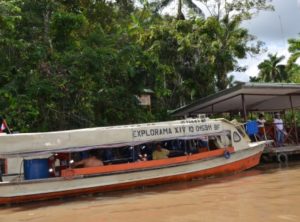 the rapido’s roof, I admired a sapphire sky so dazzling that it seemed a new name for this shade of blue needed invention. Suspended in this azure sky were giant pillows of marvelously snowy cumulus clouds. I felt that surely I was the first person ever privileged to see a sky so beautiful. The latte-colored waters of the river rolled onward beneath us. Upon its surface floated logs (our boatman had to be diligent), water lettuce, hyacinth, the occasional whole tree, and even small islands of soil with their attendant vegetation which had been ripped from the shoreline. What creatures sailed aboard these craft I wondered? To what destination were they bound? The great naturalist Charles Darwin long ago speculated that such rafts, carried out to sea from a river mouth, were the means by which many pioneering organisms reached their far ports – the Galapagos Islands for example.
the rapido’s roof, I admired a sapphire sky so dazzling that it seemed a new name for this shade of blue needed invention. Suspended in this azure sky were giant pillows of marvelously snowy cumulus clouds. I felt that surely I was the first person ever privileged to see a sky so beautiful. The latte-colored waters of the river rolled onward beneath us. Upon its surface floated logs (our boatman had to be diligent), water lettuce, hyacinth, the occasional whole tree, and even small islands of soil with their attendant vegetation which had been ripped from the shoreline. What creatures sailed aboard these craft I wondered? To what destination were they bound? The great naturalist Charles Darwin long ago speculated that such rafts, carried out to sea from a river mouth, were the means by which many pioneering organisms reached their far ports – the Galapagos Islands for example.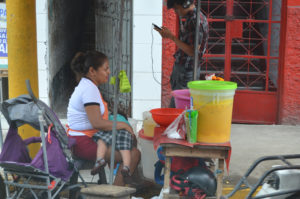 tribe. In these parts, this palm is generally referred to as aguaje and is prized for its fruits which find their way into delights ranging from ice cream to juice.
tribe. In these parts, this palm is generally referred to as aguaje and is prized for its fruits which find their way into delights ranging from ice cream to juice.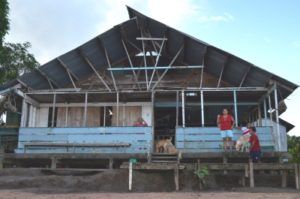 ross the river into a small stream (a quebrada) called the Yanamono. Slowly we idled past the home, small store, and bar of the Guerra family which stood at the tributary’s mouth. Close by stood the rum factory, the source of the aguardiente served in their little bar. Later I was to learn much about the potency of this sugar cane derivative. Gliding ahead we passed, on the left bank, the co
ross the river into a small stream (a quebrada) called the Yanamono. Slowly we idled past the home, small store, and bar of the Guerra family which stood at the tributary’s mouth. Close by stood the rum factory, the source of the aguardiente served in their little bar. Later I was to learn much about the potency of this sugar cane derivative. Gliding ahead we passed, on the left bank, the co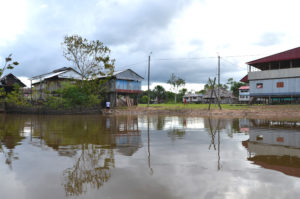 llection of houses representing the little village of Palmeras. Here lived a community of indigenous Yagua people.
llection of houses representing the little village of Palmeras. Here lived a community of indigenous Yagua people.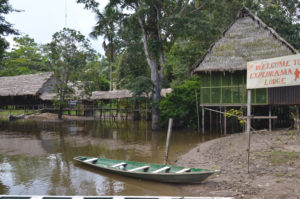
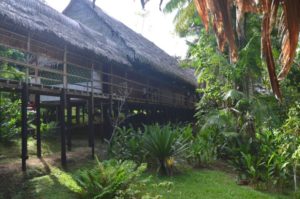 the tropical rainforest led him to build not only Explorama Lodge but other facilities as well. These include Ceiba Tops which sits on the Amazon twenty-five miles below Iquitos. With air conditioning, hot water, and a pool, it is an eco-destination for those who prefer less rustic rainforest accommodations. There is another Explorama facility on the Sucusari River (a tributary of the Napo) roughly one hundred miles east of Iquitos which is called ExplorNapo Lodge. A short hike from here brings one to the ACTS (Amazon Conservatory of Tropical Studies) Field Station, a place many visitors consider the highlight of their trip to the Explorama properties. Originally known as ACEER (Amazon Center for Environmental Education and Research), the ACTS field station is as the name suggests a focal point for tropical research. But here Explorama also maintains lodging for their guests similar to that at their other properties. However, the big attraction at ACTS is the famous canopy walkway. Suspended within the
the tropical rainforest led him to build not only Explorama Lodge but other facilities as well. These include Ceiba Tops which sits on the Amazon twenty-five miles below Iquitos. With air conditioning, hot water, and a pool, it is an eco-destination for those who prefer less rustic rainforest accommodations. There is another Explorama facility on the Sucusari River (a tributary of the Napo) roughly one hundred miles east of Iquitos which is called ExplorNapo Lodge. A short hike from here brings one to the ACTS (Amazon Conservatory of Tropical Studies) Field Station, a place many visitors consider the highlight of their trip to the Explorama properties. Originally known as ACEER (Amazon Center for Environmental Education and Research), the ACTS field station is as the name suggests a focal point for tropical research. But here Explorama also maintains lodging for their guests similar to that at their other properties. However, the big attraction at ACTS is the famous canopy walkway. Suspended within the 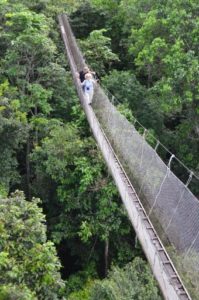 rainforest canopy, this system of walk-boards, cables, and netting extends for a third of a mile through this lofty realm. Upon this high – and tangibly thrilling – causeway guests and researchers are able to access a stratum of the rainforest which is otherwise inaccessible to those without special climbing equipment and skills. As you may discern, Peter Jensen’s legacy is a tropical rainforest ecotourism destination of extraordinary vision and accomplishment.
rainforest canopy, this system of walk-boards, cables, and netting extends for a third of a mile through this lofty realm. Upon this high – and tangibly thrilling – causeway guests and researchers are able to access a stratum of the rainforest which is otherwise inaccessible to those without special climbing equipment and skills. As you may discern, Peter Jensen’s legacy is a tropical rainforest ecotourism destination of extraordinary vision and accomplishment.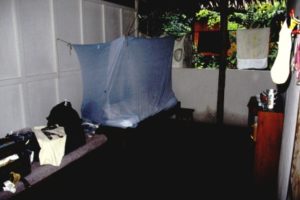 nightstand held a pitcher of river water and metal wash pan, a kerosene lamp on the wall provided light. Such lamps also lined the walkways interconnecting the many lodge buildings. Their soft, soothing light lent a magical nighttime aura to the lodge grounds. The walls of the room extended to a height of eight feet on three sides. The back wall was about four feet in height and opened directly into the surrounding forest. It was unscreened but had curtains which could be drawn closed. Towering far overhead was the actual roof of the guest building. The underside – my ceiling – revealed an artistic pattern of interwoven irapay palm leaves. The leaves had been assembled into units of roofing known as crisnejas. These
nightstand held a pitcher of river water and metal wash pan, a kerosene lamp on the wall provided light. Such lamps also lined the walkways interconnecting the many lodge buildings. Their soft, soothing light lent a magical nighttime aura to the lodge grounds. The walls of the room extended to a height of eight feet on three sides. The back wall was about four feet in height and opened directly into the surrounding forest. It was unscreened but had curtains which could be drawn closed. Towering far overhead was the actual roof of the guest building. The underside – my ceiling – revealed an artistic pattern of interwoven irapay palm leaves. The leaves had been assembled into units of roofing known as crisnejas. These 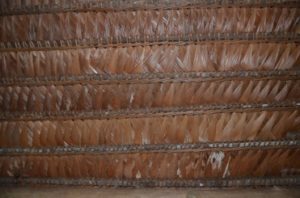 had been laid upon and lashed to rafters made of pona palm. The entire building was an amazing display of both local craftsmanship and the utility of the forest products lying at hand. (A note here: Explorama Lodge’s rooms have since been upgraded and each now has a bathroom with shower. Even generator-produced electricity and Wi-Fi are available during certain hours. A nod to progress I suppose, but the evening lamp-glow and near total isolation from the modern world I sadly miss).
had been laid upon and lashed to rafters made of pona palm. The entire building was an amazing display of both local craftsmanship and the utility of the forest products lying at hand. (A note here: Explorama Lodge’s rooms have since been upgraded and each now has a bathroom with shower. Even generator-produced electricity and Wi-Fi are available during certain hours. A nod to progress I suppose, but the evening lamp-glow and near total isolation from the modern world I sadly miss).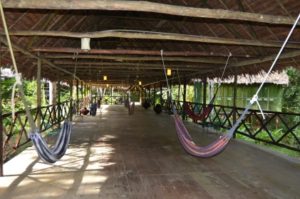 The area was unoccupied and I soon found myself blissfully relaxing as my hammock swayed gently to and fro. Soon, off in the surrounding forest, I heard a soft yet steady rain approaching. Within minutes I was surrounded by the percussive sound of a million raindrops softly striking another million multi-shaped leaves. A cool, incredibly refreshing breeze had come with the rain. And now, of a sudden, came a sound totally novel to my ears. From several points of the compass came low, soft, whooping calls. The voices resembled a muted, less robust version of the first note of the song crooned by the white-handed gibbons I had heard in Malaysia so many years ago. It was the sound of smoky jungle frogs (Leptodactylus) who had
The area was unoccupied and I soon found myself blissfully relaxing as my hammock swayed gently to and fro. Soon, off in the surrounding forest, I heard a soft yet steady rain approaching. Within minutes I was surrounded by the percussive sound of a million raindrops softly striking another million multi-shaped leaves. A cool, incredibly refreshing breeze had come with the rain. And now, of a sudden, came a sound totally novel to my ears. From several points of the compass came low, soft, whooping calls. The voices resembled a muted, less robust version of the first note of the song crooned by the white-handed gibbons I had heard in Malaysia so many years ago. It was the sound of smoky jungle frogs (Leptodactylus) who had  begun their evening’s romancing. These vocalizations have remained one of my treasured rainforest memories. Their sounds seemed archetypical of the rainforest and even now I can bring them to cognizance and find myself thus transported back to their forest. Lying in my hammock, lulled by the soothing rainfall and mesmerized by the melody of the frogs I felt sure I had found my Eden.
begun their evening’s romancing. These vocalizations have remained one of my treasured rainforest memories. Their sounds seemed archetypical of the rainforest and even now I can bring them to cognizance and find myself thus transported back to their forest. Lying in my hammock, lulled by the soothing rainfall and mesmerized by the melody of the frogs I felt sure I had found my Eden.
 In 1998 I made the first of several trips to the South American country of Peru. This first jaunt was a revelation and Peru has become perhaps my favorite foreign destination. That initial trip was made possible through the philanthropy of a Lilly Endowment Teacher Creativity Fellowship. These competitive fellowships offer Indiana teachers support for life-long learning . . . by enabling them to pursue dreams and passions, explore new areas of interest, expand existing talents, and develop new ones. How accurate their description and what excitement word of receiving a Fellowship created in our house! Anne and daughter Michelle surprised me with a tray holding the just arrived letter of selection emblazoned with the Lilly Endowment letterhead. Accompanying the announcement of my good fortune was a bottle of pinot grigio and three glasses. The celebration was on!
In 1998 I made the first of several trips to the South American country of Peru. This first jaunt was a revelation and Peru has become perhaps my favorite foreign destination. That initial trip was made possible through the philanthropy of a Lilly Endowment Teacher Creativity Fellowship. These competitive fellowships offer Indiana teachers support for life-long learning . . . by enabling them to pursue dreams and passions, explore new areas of interest, expand existing talents, and develop new ones. How accurate their description and what excitement word of receiving a Fellowship created in our house! Anne and daughter Michelle surprised me with a tray holding the just arrived letter of selection emblazoned with the Lilly Endowment letterhead. Accompanying the announcement of my good fortune was a bottle of pinot grigio and three glasses. The celebration was on! two thousand miles must be navigated downstream to reach the river’s mouth in Brazil. No roads arrive in Iquitos from the far away capital of Lima. No by-ways link Iquitos to the urban areas of next door neighbors Ecuador, Colombia, and Brazil. If one wants to venture here, one flies or voyages upon the Amazon. It is indeed an islet in a tropical rainforest sea.
two thousand miles must be navigated downstream to reach the river’s mouth in Brazil. No roads arrive in Iquitos from the far away capital of Lima. No by-ways link Iquitos to the urban areas of next door neighbors Ecuador, Colombia, and Brazil. If one wants to venture here, one flies or voyages upon the Amazon. It is indeed an islet in a tropical rainforest sea. Vignetta International Airport, I took note of a familiar reminder that I was in the tropics. My glasses had lightly fogged and trickles of perspiration began to make leisurely meanders down my sides, wetting my shirt in the process. Having lived in tropical Southeast Asia for three years, the sensation wasn’t new to me. However, a few years in temperate Indiana had allowed me to forget just how incredibly humid the tropics can be. In fact regions which harbor tropical rainforest share several climatic characteristics, high humidity being just one of these. The average RH for the Iquitos area is in the low 80’s. Think of the hottest, most humid summer day that you can recall here in the Midwest and you have some idea of the feel, be it January or June, of the lowland tropics.
Vignetta International Airport, I took note of a familiar reminder that I was in the tropics. My glasses had lightly fogged and trickles of perspiration began to make leisurely meanders down my sides, wetting my shirt in the process. Having lived in tropical Southeast Asia for three years, the sensation wasn’t new to me. However, a few years in temperate Indiana had allowed me to forget just how incredibly humid the tropics can be. In fact regions which harbor tropical rainforest share several climatic characteristics, high humidity being just one of these. The average RH for the Iquitos area is in the low 80’s. Think of the hottest, most humid summer day that you can recall here in the Midwest and you have some idea of the feel, be it January or June, of the lowland tropics. as well. The average high throughout the year in Iquitos is around 870F with nighttime temperatures running around 720F. (climatogram courtesy of Climate-Data.org) Here in the Midwestern U.S., differences between highs and lows throughout the year vary by a good 600F. In fact, here in Indiana a fast moving cold front, sweeping down from the Arctic, can drop the temperature that much in a matter of hours. And, of course, there is lots of rain. Iquitos receives a bit over one-hundred and ten inches per year compared with about forty inches here in Indiana.
as well. The average high throughout the year in Iquitos is around 870F with nighttime temperatures running around 720F. (climatogram courtesy of Climate-Data.org) Here in the Midwestern U.S., differences between highs and lows throughout the year vary by a good 600F. In fact, here in Indiana a fast moving cold front, sweeping down from the Arctic, can drop the temperature that much in a matter of hours. And, of course, there is lots of rain. Iquitos receives a bit over one-hundred and ten inches per year compared with about forty inches here in Indiana. child and a sleeping infant, paddled their way upstream in a dugout canoe bound for the city and its storehouse of goods and urban marvels. Hugging the shoreline was another dugout; this one occupied by two children who couldn’t have been more than ten years old. They quietly fished for their family’s dinner as we sped onward. An open skiff, known locally as a pequi-pequi , motored by a fisherman at the helm. The boat’s small four-stroke engine sang with the “peck-peck-peck” sound which gave the craft its indigenous name. Farther downstream another, larger boat came chugging into view making way for Iquitos. This was a craft known as a colectivo. Colectivos are the water-taxis of a region with no roads.
child and a sleeping infant, paddled their way upstream in a dugout canoe bound for the city and its storehouse of goods and urban marvels. Hugging the shoreline was another dugout; this one occupied by two children who couldn’t have been more than ten years old. They quietly fished for their family’s dinner as we sped onward. An open skiff, known locally as a pequi-pequi , motored by a fisherman at the helm. The boat’s small four-stroke engine sang with the “peck-peck-peck” sound which gave the craft its indigenous name. Farther downstream another, larger boat came chugging into view making way for Iquitos. This was a craft known as a colectivo. Colectivos are the water-taxis of a region with no roads.  Frequently comprised of two or three decks, these boats are large by local river standards often measuring forty feet or more in length. The vessel was crowded with passengers. Some lounged, chatting in small groups. Others lazed in hammocks strung about in random exploitation of available spaces. Accompanying the human passengers was a menagerie of chickens, a couple of pigs, and what appeared to be a young Brahman steer. Pablo informed me that each of these critters, like the passengers, endured a fare equivalent to their perceived value.
Frequently comprised of two or three decks, these boats are large by local river standards often measuring forty feet or more in length. The vessel was crowded with passengers. Some lounged, chatting in small groups. Others lazed in hammocks strung about in random exploitation of available spaces. Accompanying the human passengers was a menagerie of chickens, a couple of pigs, and what appeared to be a young Brahman steer. Pablo informed me that each of these critters, like the passengers, endured a fare equivalent to their perceived value.